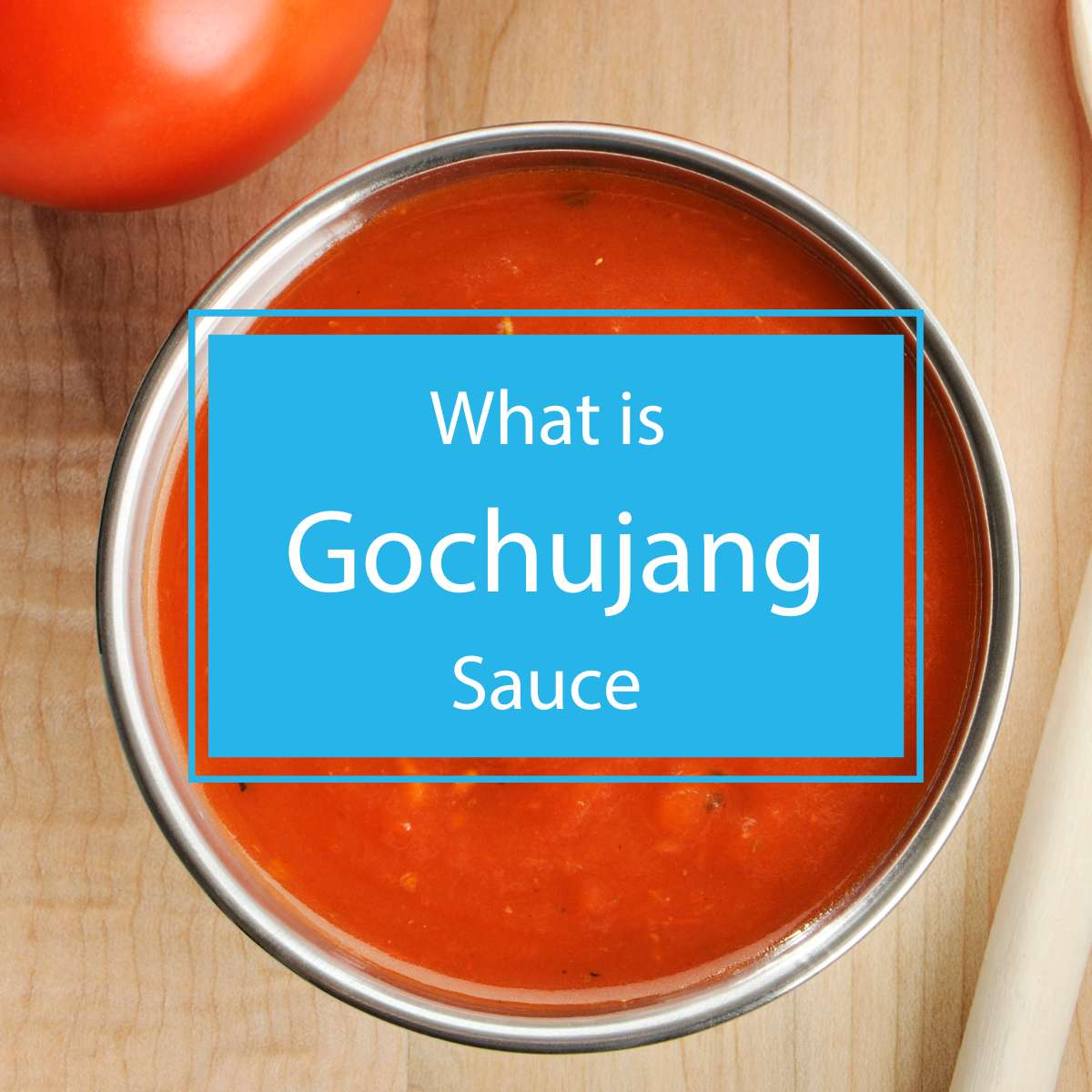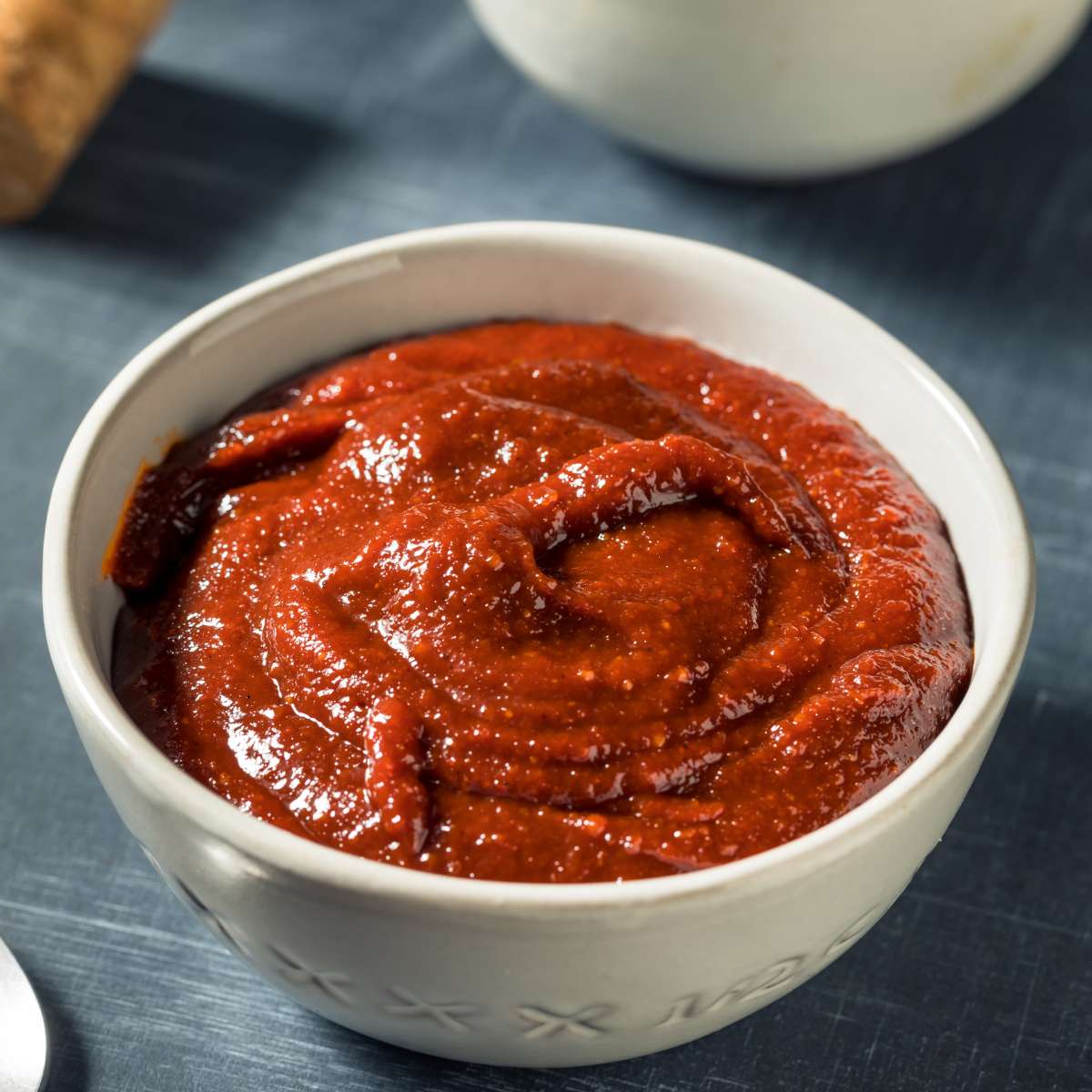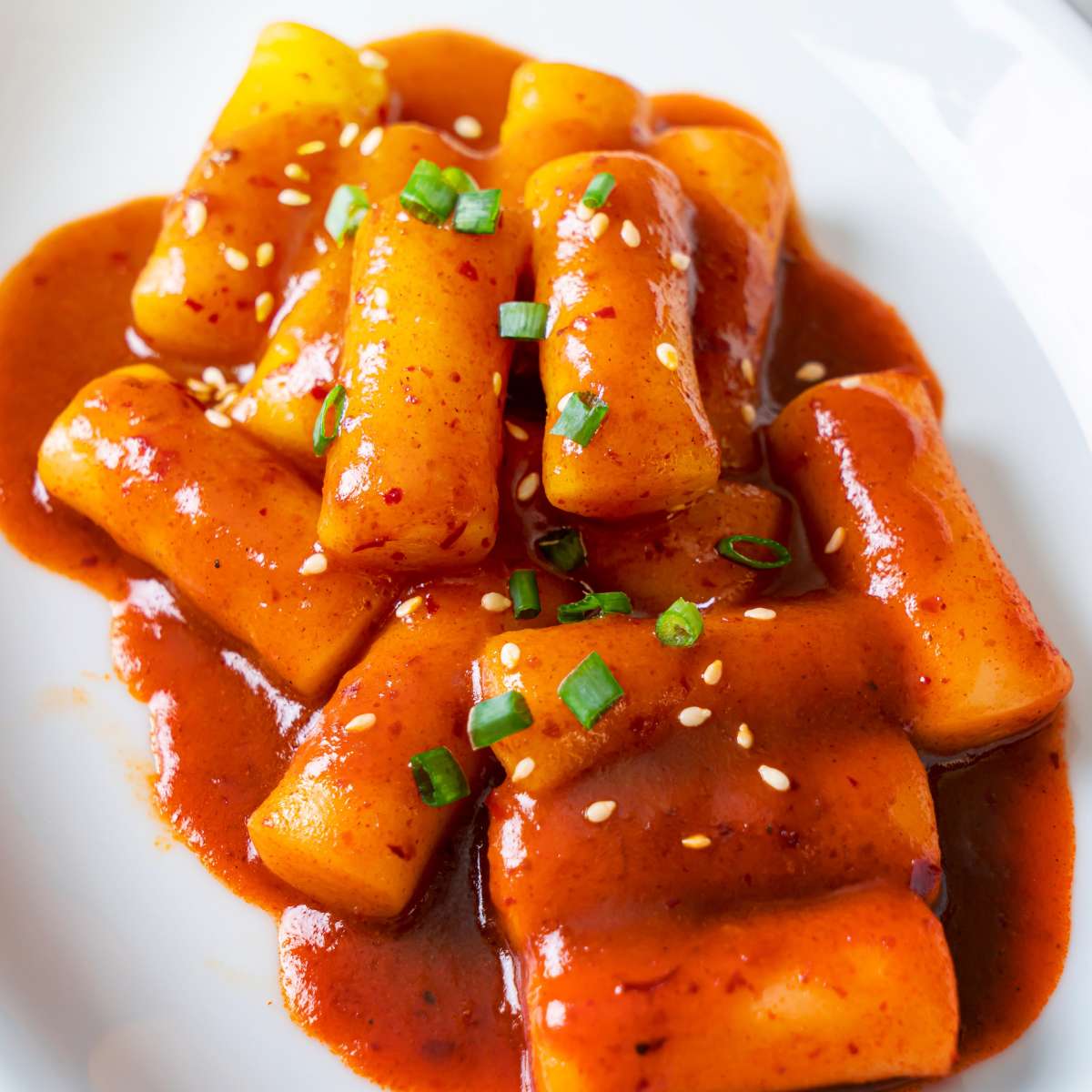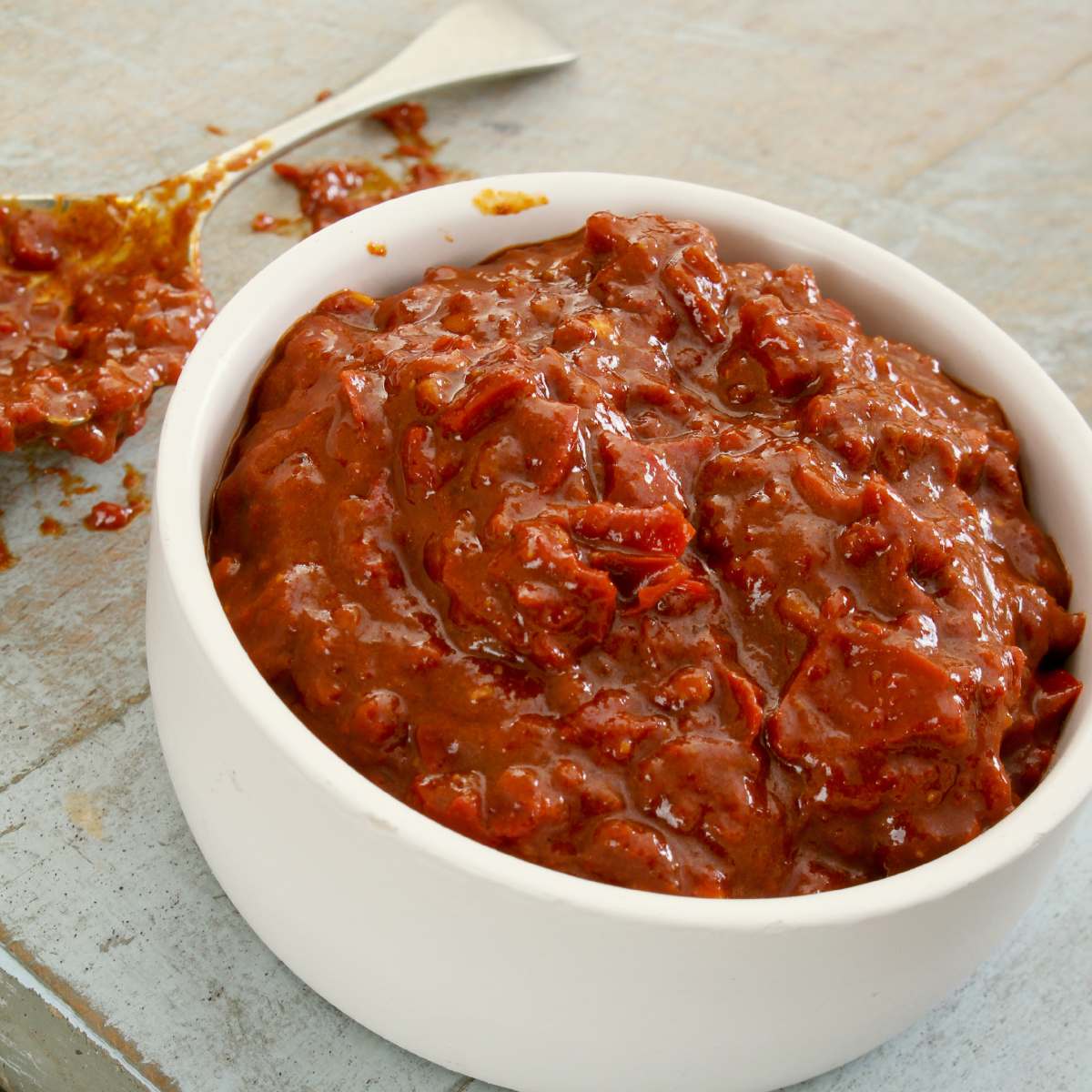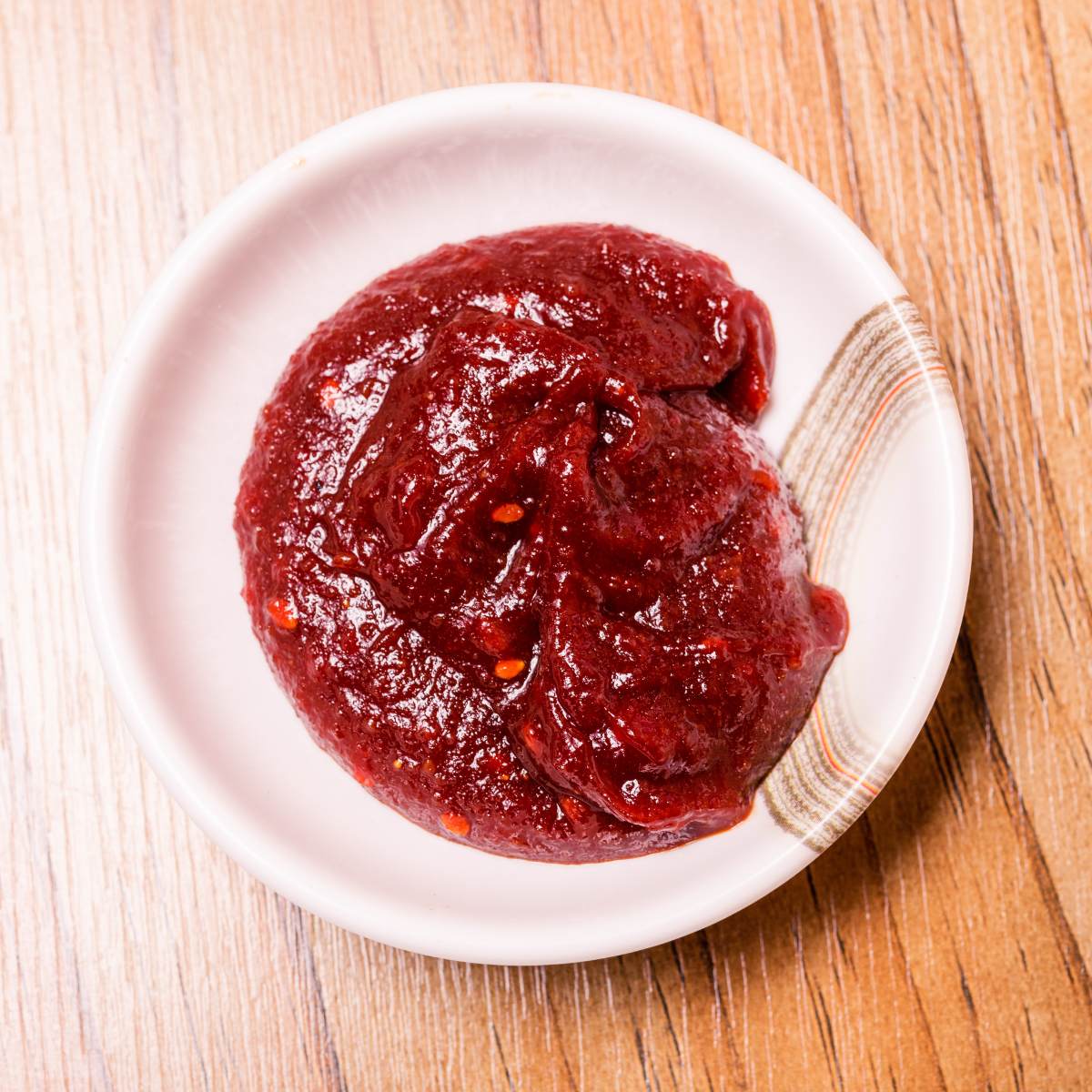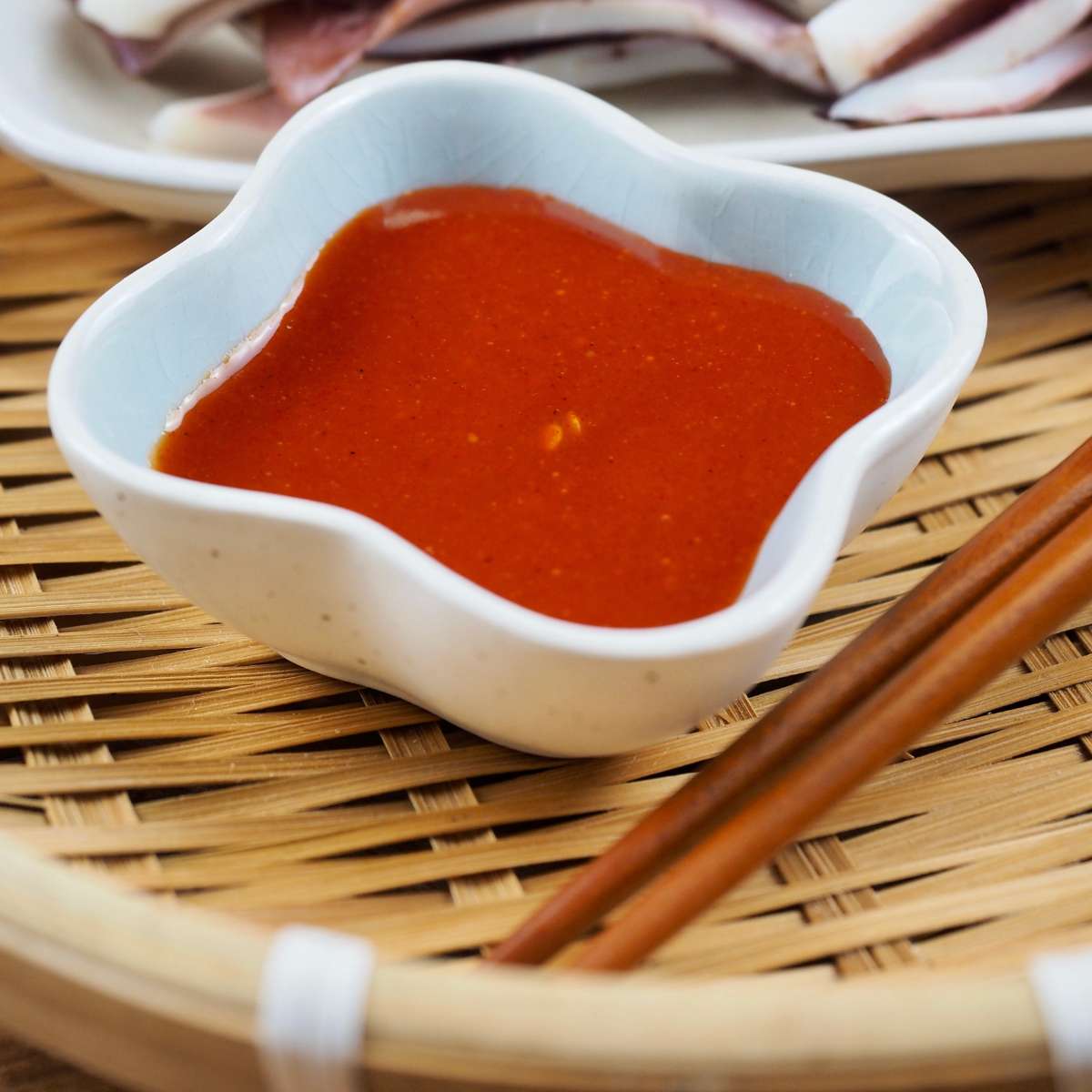Are you ready to elevate your culinary game with the tantalizingly complex flavors of Korean cuisine? Look no further than gochujang sauce, a fiery and savory condiment that is captivating the tastebuds of gourmet food enthusiasts across the United States.
This zesty paste, reminiscent of a blend between sriracha and miso with a hint of sweetness, packs an unforgettable punch, taking your dishes to a new level.
Let’s embark on a journey to discover the rich history and flavorsome versatility of gochujang, as we unveil the secrets behind this spicy staple in Korean cuisine.
Key Takeaways
- Gochujang sauce is a fiery and savory Korean condiment.
- Known for its complex flavor profile, it combines spicy, sweet, and umami notes.
- Traditionally made using gochugaru (Korean chili powder), glutinous rice, and fermented soybeans.
- Gochujang’s increasing popularity in the US is due to the growing appreciation for Korean cuisine, spicy food, and fermented foods.
- Used in various dishes like marinades, soups, stews, and sauces – enhancing the overall flavor profile.
- Offers numerous health benefits due to its fermentation process and ingredient makeup.
- A versatile and valuable addition to anyone’s culinary repertoire.
PRO TIP: mix with mayonnaise if you want it less spicy, and use this as a sauce for burgers, fried rice, etc… My 12 and 13 year old boys like to mix it with their rice when they want a little flavor.
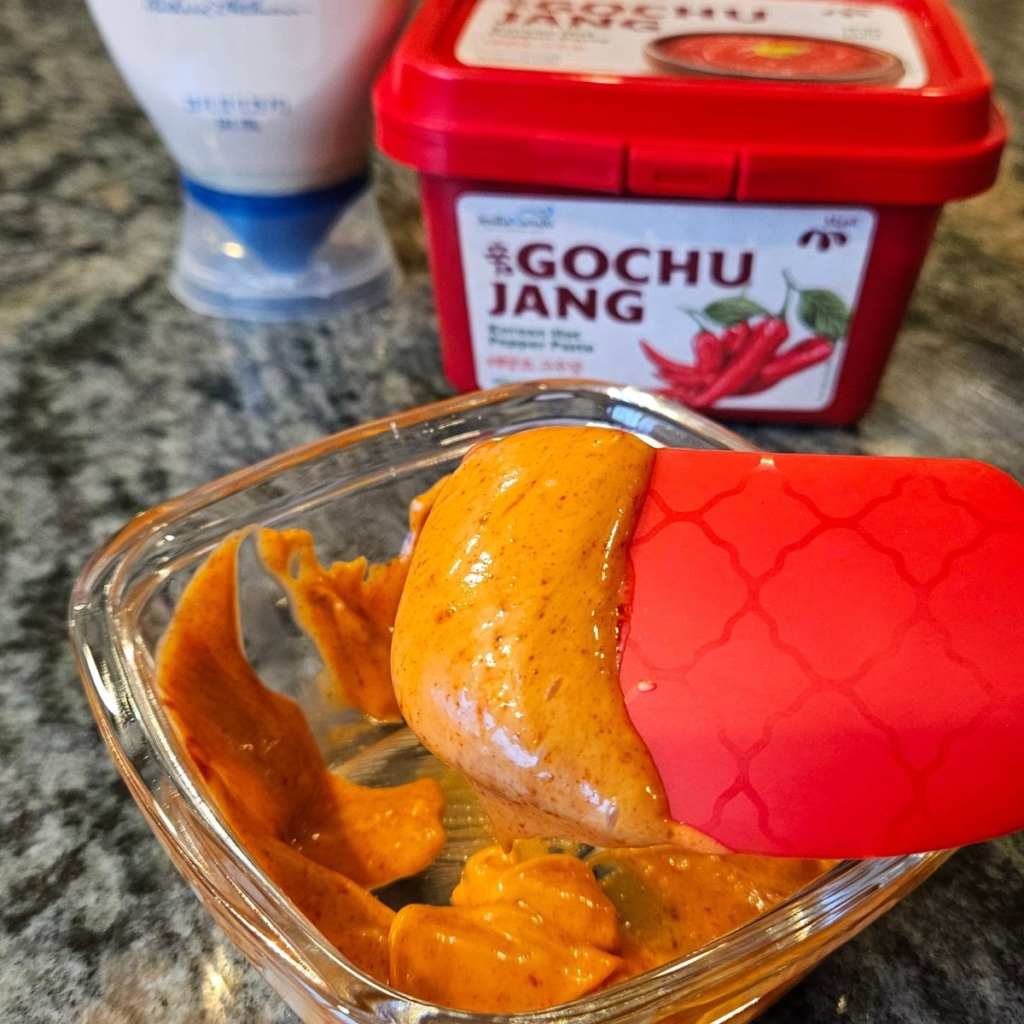
The Historical Significance of Gochujang
Gochujang has been an integral part of Korean food culture for centuries. Each household in Korea would traditionally prepare their gochujang annually, symbolizing a deep-rooted custom. This reverence for gochujang contributes to its status as a culinary treasure.
Its historical significance is reflected in its centuries-old presence in Korean cuisine, where it has been used as a key ingredient in various delectable dishes.
Why Gochujang is Gaining Popularity in the US
In the United States, the growing appreciation for Korean food, particularly dishes bearing the distinctive flavor of gochujang, has driven the popularity of this spicy condiment. Its rise can be attributed to the convergence of trends that include:
- A broader interest in global culinary traditions
- An inclination towards spicier flavors
- An increased focus on the health benefits of fermented foods
As more Americans become familiar with the unique taste and versatility of gochujang, its use in various recipes has expanded, showcasing its potential as an essential ingredient in contemporary American cuisine.
I also think that since sriracha (on Amazon) has taken roots as a new spicy favorite in many restaurants Asian and non-asians alike, other spicy flavors are starting to emerge in American cuisine as well. I remember when I was growing it, it was rare to see a bottle of sriracha (on Amazon) at a non-Asian restaurant. Now, as an adult, I frequently see it in sub shops and some restaurants.
As a kid, the only place I ever saw it was at Vietnamese Pho restaurants where it is typically right next to a bottle of hoisin sauce (on Amazon)!

It’s no wonder that we’re starting to explore other asian spicy flavors, since sriracha (on Amazon) was adopted so well!
The Complex Flavor Profile of Gochujang
While many fermented sauces dominate the culinary world, gochujang stands out for its unique combination of flavors. This quintessential Korean condiment offers a delectable mixture of spicy, savory, and sweet elements, setting it apart from its close counterparts, sriracha, and miso.
Let’s explore how the taste of gochujang differs from these popular sauces and which key ingredients contribute to its distinctive taste.
Gochujang Vs. Sriracha and Miso: A Taste Comparison
Sriracha, the popular Thai chili sauce, is known for its bold heat, tanginess, and hint of sweetness. But when it comes to the complex flavor profile of gochujang, sriracha only covers part of the spectrum.
The savory depth of umami found in miso, a Japanese fermented soybean paste, is what brings gochujang’s flavor closer to completion. With the added element of sweetness, gochujang manages to strike the perfect balance between these multifaceted flavors.
Key Ingredients Contributing to Gochujang’s Unique Taste
Gochujang’s unparalleled flavor is a result of the harmonious blend of four key ingredients, each playing a crucial role in achieving its spicy, savory, and sweet taste:
- Gochugaru: This Korean chili powder provides the heat and vivid red color to gochujang.
- Salt: An essential element in any fermented sauce, salt enhances the flavors and aids in the fermentation process.
- Glutinous rice: It offers a subtle sweetness and provides the thick texture that makes gochujang perfect for sauces and marinades.
- Fermented soybeans: They are responsible for the savory depth of umami, which defines gochujang’s characteristically pungent taste.
The fermentation process is critical in allowing these ingredients to interact and develop the unique flavor profile that defines gochujang. By understanding its distinctive flavor journey and key components, you can harness the full culinary potential of this versatile fermented sauce in your dishes.
What is Gochujang Sauce
Gochujang sauce, commonly referred to as Korean red chili paste, holds a prominent place in the realm of Korean cuisine as an essential ingredient with significant culinary versatility.
Crafting a harmonious combination of deeply savory, spicy, and slightly sweet flavors, gochujang owes its unique taste to a blend of red chili pepper flakes, glutinous rice, fermented soybeans, and salt.
This spicy-sweet paste is a must-have for those seeking to introduce authentic Korean flavors into their dishes.
Gochujang doesn’t just make your taste buds dance; it tells a story of rich culture and gastronomic heritage on every plate.
This indispensable ingredient is used to boost flavor in a variety of dishes, including enhancing meat marinades, injecting a surge of heat into soups and stews, and offering a depth of taste to sauces. Due to its highly concentrated flavor profile, gochujang is often combined with other ingredients, rounding out the intense punch it brings to gastronomic creations.
Looking to expand your culinary repertoire? Let’s explore the diverse ways gochujang sauce can enliven your dishes and become a staple in your pantry:
- Transform ho-hum marinades into zesty, flavor-packed sensations
- Intensify soups and stews with a touch of umami and a kick of spice
- Create mouthwatering sauces with complex flavor profiles
- Experiment with fusion dishes for an unexpected gastronomic treat
As you venture into the world of Korean cuisine and beyond, embracing the allure of gochujang sauce will surely enrich your culinary journey with savory, spicy, and sweet memories.
Crafting Gochujang: A Look into Its Artisanal Production
The art of gochujang-making is a time-honored craft that balances tradition with modern techniques, all while maintaining its artisanal essence. Let’s delve into the fascinating world of gochujang production, from its roots in earthenware jugs to the present-day fermentation process which is a transformative experience for both the paste and its connoisseurs.
From Earthenware Jugs to Modern Fermentation
Historically, gochujang would ferment in earthenware jugs called onggi, under the sun’s warm embrace. With starches in glutinous rice gradually transforming into sugars, the sun’s heat would coax subtle sweetness from the paste.
Nowadays, many manufacturers use modern fermenters to achieve consistent results; however, artisanal production of gochujang still retains the time-tested tradition of fermentation in onggi.
Gochujang’s Fermentation: A Process of Transformation
The key to mastering gochujang’s complex flavor lies within the lengthy period of traditional fermentation. This transformative process can span anywhere from months to years, with the ingredients interacting and maturing to develop the paste’s distinctive taste.
As the seasons change, the sauce undergoes a gochujang making metamorphosis – the harmonious blend of spicy, savory, and sweet renders this culinary creation truly extraordinary.
Here’s a quick summary of gochujang’s production timeline and its fascinating transformation:
- Fermentation of soybeans: essential for umami depth and richness.
- Blending of ingredients: optimal proportions of gochugaru, glutinous rice, salt, and fermented soybeans are combined.
- Maturation in onggi or modern fermenters: exposure to natural elements like sunlight and temperature fluctuations allows the sauce to develop its complex flavors.
- Packaging and distribution: ready for enthusiasts to experience gochujang’s culinary prowess.
With such a storied past and intricate production process, gochujang truly stands as a testament to the rich heritage, time-honored techniques, and passion that go into creating this iconic Korean condiment.
Next time you incorporate gochujang into your cooking, remember the journey it has undertaken – from humble beginnings to your taste buds, a flavorful adventure like no other.
Gochujang in Everyday Cuisine: From Marinades to Condiments
Stepping beyond the boundaries of traditional Korean dishes, gochujang has found its rightful place in everyday cuisine. Its versatility lends itself to applications in marinades, stews, and stir-fries, creating a flavor foundation in iconic Korean barbecue and the delectable bibimbap.
In the United States, gochujang has further expanded its reach, spicing up barbecue sauces and gracing “spicy Korean-style” dishes in eateries. As you’ll see, cooking with gochujang can introduce an array of mouthwatering possibilities beyond Korean cuisine, including dips, dressings, and unconventional takes on common dishes.
Incorporating Gochujang into Marinades and Sauces
When it comes to cooking with gochujang, this fiery red paste shines as an indispensable ingredient in marinades for meats and vegetables. Its complex flavor profile adds depth and a kick of spiciness, making it a must-have for everything from beef bulgogi to spicy mushroom skewers.
Moreover, it can elevate your homemade sauce game: mix it into barbecue sauce for an interesting twist, or simply combine with yogurt, lime juice, and a touch of honey to create a zesty dipping sauce that’s sure to impress guests.
Gochujang’s Role in Iconic Korean Dishes
Two dishes where gochujang truly steals the show are Korean barbecue and bibimbap. In a Korean barbecue setting—whether it’s pork belly, thinly sliced beef, or succulent chicken—gochujang based marinades impart a rich, savory flavor that’s downright addictive.
Similarly, the mouthwatering bibimbap incorporates a generous dollop of gochujang, which is then mixed with assorted vegetables, rice, and a protein of choice to deliver a harmonious medley of flavors.
But don’t limit yourself to just these dishes—dare to experiment and see how gochujang can spice up everyday meals, be it a simple stir-fry or a fusion-inspired noodle dish. Cooking with gochujang is an opportunity to explore new flavors while celebrating its uniquely Korean roots.
Mastering the Use of Gochujang in Cooking
To truly master the art of cooking with gochujang, start by using it sparingly – a teaspoon can make a significant impact. Its concentrated spiciness makes it ideal for blending into other ingredients, whether you’re experimenting with Western dishes or sticking to Korean classics.
By incorporating gochujang into various culinary creations, you can infuse a powerful umami punch, complemented by its trademark kick of heat.
Here are some tips to enhance your cooking techniques and elevate your flavor game with gochujang:
- Experiment with proportions: Gradually increase the amount of gochujang to suit your taste preferences and tolerance for heat.
- Combine with complementary ingredients: Mix gochujang with other sauces or seasonings to create unique condiments, marinades, or dressings.
- Get creative: Don’t limit yourself to traditional Korean dishes – apply your culinary experimentation skills by incorporating gochujang into unexpected recipes such as burgers, tacos, and even desserts.
- Adjust cooking techniques: Grilling, sauteing, or roasting foods with gochujang can result in different flavor profiles and intensity levels.
For some culinary inspiration, check out this table of popular dishes that incorporate gochujang for maximum flavor enhancement.
| Dish | Category | Gochujang Application |
|---|---|---|
| Tteokbokki | Korean Street Food | Sauce for rice cakes and fish cakes |
| Kimchi Fried Rice | Rice Dish | Stir fried with kimchi, rice, and other ingredients |
| Gochujang Glazed Salmon | Seafood | Glaze for grilling or baking |
| Korean Chicken Wings | Appetizer | Sauce for crispy fried wings |
Remember that the key to mastering gochujang in cooking lies in your willingness to experiment, adapt, and explore different flavor combinations. With practice and a sense of culinary adventure, you will undoubtedly breathe new life into your dishes using this versatile condiment.
Gochujang’s Health Benefits: More than Just Flavor
While gochujang is highly revered for its unique taste, it also offers numerous health benefits that make it an even more impressive ingredient in your kitchen.
Digestive Health and Fermentation
The traditional fermentation process that goes into making gochujang results in a rich source of probiotics, which are beneficial for maintaining a healthy digestive system. In fact, Korean physicians historically prescribed gochujang to patients with digestive issues, recognizing the positive impact of these probiotics.
Antioxidant Properties and Metabolism Boosting Effects
Loaded with antioxidants, gochujang can help combat oxidative stress in the body. Furthermore, it is a potent source of capsaicin, the compound responsible for the heat in chili peppers. Capsaicin has been shown to increase metabolism, potentially aiding in weight loss.
Thus, incorporating gochujang into your diet not only elevates the flavor of your dishes but also contributes to your overall health and well-being.
Authentic Gochujang on Amazon for around $10
 Buy Now →
Buy Now → (on Amazon)
Finding Gochujang: A Guide to Locating This Spicy Staple
Discovering authentic gochujang can be an adventure through the grocery aisles as you search for this unique Korean hot pepper paste. When navigating stores, keep in mind it might not be found in every supermarket, making a trip to your local Asian market an exciting part of the process.
It can also be found on Amazon for around $8! Gochujang (on Amazon) comes in a squeeze tube, but I recommend you opt for the tub, which is much more authentic. My kids like to mix it with mayonnaise and use that as a spicy sauce for anything they like.
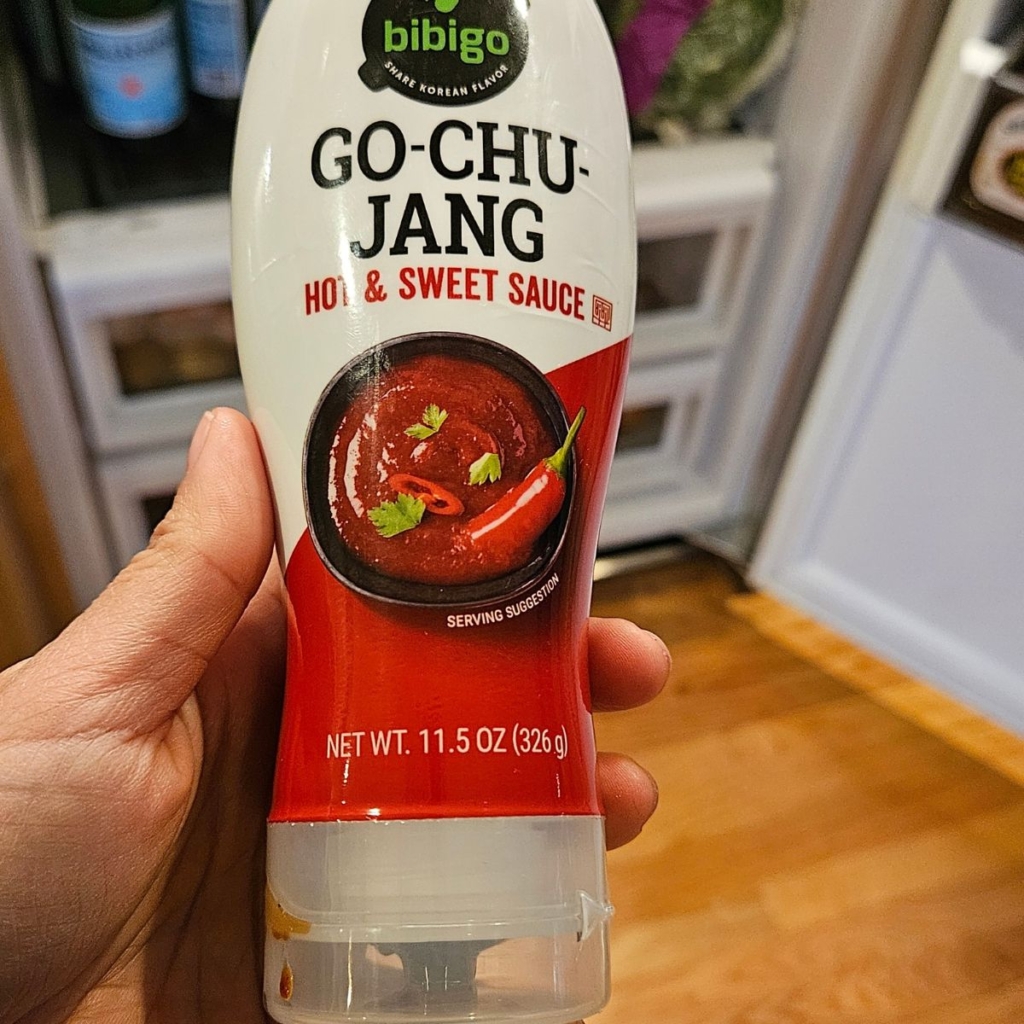
Navigating Grocery Aisles for Authentic Gochujang
Your best chance to find gochujang lies in the refrigerated international section of larger supermarkets. Look for a distinctive red, rectangular tub that marks the presence of this Korean condiment. If your local grocery store does not stock gochujang, don’t fret. A visit to nearby Asian markets will likely result in a successful grocery shopping experience for finding gochujang, or simply buy it on Amazon for $5-$10!
It comes as a squeeze tube, which is convenient and less wasteful, but in my opinion you have to get the tub! It has a richer, deeper taste profile than the squeeze tube.
Common Brands and Varieties of Gochujang
When shopping for gochujang, keep an eye out for popular brands such as Mother in Law and Haechandle. These brands offer gochujang commonly labeled as “hot pepper paste.” Be sure to differentiate authentic gochujang from gochujang sauce, which may contain additional ingredients, and doenjang, another type of Korean fermented paste.
Embarking on the culinary journey of incorporating gochujang into your dishes starts with finding the right product. As you explore the world of Asian markets and grocery stores, you’ll be well on your way to spicing up your kitchen with this flavorful staple.
Culinary Inspiration: Diverse Ways to Enjoy Gochujang
Gochujang’s unique balance of sweet, spicy, and savory flavors has inspired innovative uses in various cuisines, often elevating traditional dishes with its distinct kick. From fusion plates to modern reinventions, gochujang has proven its ability to transcend cultural boundaries and revitalize an array of recipes.
Gochujang-Infused Innovation in Western Cuisine
Western cuisine has embraced gochujang, incorporating the flavorsome paste into various dishes and cuisines. For instance, its bold taste adds a burst of flavor to American staples like BBQ sauces, seasoning blends and dips, making them more vibrant. As the appreciation for gochujang grows in the West, so does its culinary usage, inspiring countless flavor innovations.
When you get Gochujang (on Amazon) in a tub, it is thick and has a deep, spicy flavor profile, like this thick paste shown below.
And don’t forget, you can also mix it with some mayonnaise to temper the spiciness. My teen boys love that! Just like coffee….just keep mixing until the right “color” emerges. Start with one teaspoon of gochujang (on Amazon) and 1 tablespoon of mayonnaise and see what you get!

Traditional Dishes Reinvented with a Gochujang Twist
Besides its versatile use in Western cuisine, gochujang has also been employed to put a modern spin on Korean classics. Using gochujang to reimagine traditional dishes pays homage to its cultural heritage, while opening the doors to exciting, contemporary creations.
From updates on classic soups and stews to inventive spins on timeless rice dishes, gochujang is the key to unlocking a world of culinary inspiration.
Experiment with gochujang to add a punch of flavor and a touch of cultural richness to your culinary creations. Whether you are venturing into fusions or refining age-old recipes, this delightful paste will introduce you to a thrilling gastronomic journey.
Storing Your Gochujang: Tips for Longevity and Freshness
Once you’ve discovered the incredible flavor of gochujang, you’ll want to keep it tasting fresh for as long as possible. To achieve this, it is vital to know proper storage methods. This section offers guidance on maintaining the optimal quality and freshness of your gochujang, ensuring that your spicy Korean paste lasts and remains ready for your next culinary adventure.
Refrigeration and Shelf Life of Gochujang
Storage tips for gochujang are quite straightforward. To extend its shelf life, store opened gochujang in the refrigerator. When sealed and unopened, it can be stored at room temperature. Similar to miso, gochujang has a long shelf life due to its fermentation process.
Still, it’s important to monitor the expiration date while taking note of changes in its appearance or consistency, signaling that it may be past its prime.
Signs That Your Gochujang Is Past Its Prime
Although gochujang is known for its longevity, it can still spoil if stored improperly or kept for too long. To preserve the freshness of condiments, including gochujang, keep an eye out for the following signs:
- Drying out or hardening of the paste
- Significant changes in color, such as darkening or fading
- An off smell or taste, indicating spoilage
If you notice any of these signs, it’s best to err on the side of caution and dispose of your gochujang, replacing it with a fresh batch. Proper storage and mindful observation of the product will help ensure a consistently delicious and flavorful gochujang experience for your favorite Korean dishes.
Savoring the Heat: Recipes That Highlight Gochujang
Gochujang’s versatility shines in global recipes, transforming conventional dishes into flavorful masterpieces. This unique, spicy-sweet umami boost makes it a star ingredient in various global recipes, adding a Korean twist that is both savory and spicy.
Gochujang’s Versatility in Global Recipes
Whether you are a fan of Korean cuisine or just looking for new ways to spice up your cooking repertoire, gochujang is a fantastic addition to a wide range of dishes.
From cultural classics like Korean bulgogi and bibimbap to global favorites such as slow-roast chicken or flavorful stir-fried noodles, this versatile condiment effortlessly enhances the flavors of any meal.
Must-Try Recipes Featuring Gochujang as the Star Ingredient
Here are some must-try feature recipes that incorporate gochujang-based cooking, showcasing its remarkable ability to complement different cuisines:
- Korean BBQ Tacos: This fusion dish combines tender, gochujang-marinated beef with a zesty slaw wrapped in a soft tortilla, resulting in a perfect blend of Korean and Mexican flavors.
- Gochujang-Glazed Salmon: Combine the smoky and spicy flavors of gochujang with a touch of sweetness to create a delectable glaze for oven-baked salmon.
- Gochujang Fried Rice: Transform your everyday fried rice into a fiery culinary masterpiece by adding a generous dollop of gochujang, mixed vegetables, and protein of your choice.
- Spicy Gochujang Noodle Soup: A soul-warming bowl of noodle soup featuring gochujang’s fiery kick, which will delight fans of spicy, savory broths.
When using gochujang in recipes, it’s often necessary to thin it out for easier incorporation, owing to its thick texture. To do this, mix the paste with a small amount of water, oil, or other complementary sauces, making it more manageable and easier to mix with other ingredients.
This will ensure that the gochujang-based cooking creates a beautifully balanced and flavorful dish every time.
FAQ
What is the difference between gochujang, sriracha, and miso?
Gochujang is a Korean chili paste with a spicy-sweet flavor profile, resulting from ingredients like gochugaru (Korean chili powder), glutinous rice, and fermented soybeans. Sriracha is a Thai hot sauce made from chili peppers, garlic, vinegar, sugar, and salt. Miso, on the other hand, is a Japanese fermented soybean paste with a savory, umami taste. Gochujang combines the heat of sriracha with the savory depth of miso, along with an unexpected sweet undertone.
Can gochujang be used in non-Korean dishes?
Yes, gochujang is a versatile ingredient that can be used in various non-Korean recipes like sauces, dips, salad dressings, and more. It adds a spicy, savory, and slightly sweet taste that can enhance the flavor profile of many dishes.
What are the health benefits of gochujang?
Gochujang contains probiotics from its traditional fermentation process, which can aid in digestive health. It also contains antioxidants and capsaicin, which is known to boost metabolism, making it a flavorful and health-promoting ingredient.
Where can I find gochujang in the grocery store?
Gochujang can be found in the refrigerated international section of larger supermarkets or at Asian markets. Keep an eye out for popular brands like Mother in Law and Haechandle, and look for labels that say “hot pepper paste.”
What are some popular dishes that feature gochujang?
Gochujang is an essential ingredient in many Korean dishes like Korean barbecue and bibimbap. It is also commonly used in marinades, stews, and stir-fries, as well as fusion dishes and innovative takes on Western cuisine.
How should I store gochujang after opening?
To maintain freshness and quality, store opened gochujang in the refrigerator. Though it has a long shelf life, watch for signs of spoilage like drying out and changes in color.
